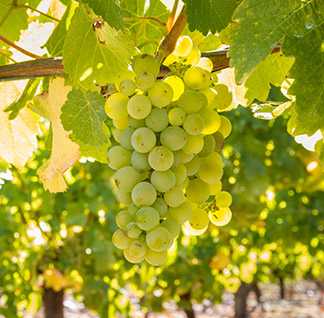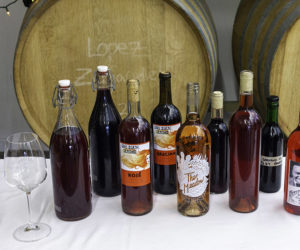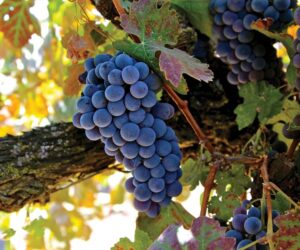
Slightly sunburnt, and thoroughly sweaty, I cut the lawn mower after a long day of gardening and yard work. While I will complain about it to anyone who will listen, gardening and yard work are a treasured ritual of my summers; a moving meditation of removing the weeds and mental stress of the week and creating a beautiful environment to be enjoyed. Often starting early on a Saturday morning to beat the New England summer heat and humidity, I will toil in the yard until the apex of the heat of the day begins around 2 p.m. Now comes time for the perk of my weekly yard work ritual, cracking open a cold bottle of Sauvignon Blanc. I will pour a big glass of Sauvignon Blanc, sit in one of my Adirondack chairs and savor the pairing of a freshly cut lawn and tired muscles with the refreshingly cold, citrusy, and grassy “Savvy B.”
Sauvignon Blanc, or Savvy B as it is known in my home, is my go-to white wine. I prize it for its lush flavors of grapefruit, grass, and herbs with an incredibly refreshing quality due to its high acidity. For me, it is a crisp, light accompaniment to any summer evening. Often a unifying crowd pleaser, when I do not want to serve something as rich as a Chardonnay but desire a slightly bolder flavor profile than a delicate Pinot Grigio, Sauvignon Blanc comes to the rescue with its strong aromatics and palate energizing citrus flavor profile. It’s an irresistible pairing to grilled shrimp, marinated chicken kabobs, or a chilled ceviche.
Sauvignon Blanc is a revered grape variety originating in the Loire Valley of France, as a variation of the Savagnin ancient grape variety. Savagnin cross pollinated with another unknown variety of grape to create the vine that is now known as Sauvignon Blanc. Sauvignon Blanc was named from the French word for wild (sauvage) and vine (vigne). After spreading throughout France as a popular viticultural choice of farmers, Sauvignon Blanc crossed with Cabernet Franc in the 1700s to create their prized offspring: Cabernet Sauvignon. Cabernet Sauvignon needs no introduction to our oenophile readers but was not understood to be a genetic offspring of Sauvignon Blanc until the research of Dr. Carole Meredith of UC-Davis in the 1990s. Up until that point, grape geneticists did not think that a red grape could have a white grape as a genetic parent.
Sauvignon Blanc made its journey from France to the winemaking regions of California in the 1870s. Charles Wetmore obtained cuttings of Sauvignon Blanc vines from France’s most prestigious growers at the time, including the acclaimed Château d’Yquem. These cuttings were originally planted in Livermore, on the eastern banks of the San Francisco Bay. These famed cuttings have spread around California vineyards and are known as the “Clone 1” of Sauvignon Blanc in California.
Another popular clone is what was referred to for decades as Sauvignon Musqué. Sauvignon Musqué is an intensely aromatic Sauvignon Blanc clone, interpreted to be a different variety before the prevalence of genetic testing in agricultural applications. After these modern advancements became more prolific and accessible to researchers, grape geneticists discovered that Sauvignon Blanc and Musqué are genetically identical, making the Musqué a different clone of its original Blanc. Both clones are planted widely all over the world and are often blended together to create aromatic complexity in the finished wine.
In the Vineyard
It’s “wild” or “sauvage” name is no coincidence on behalf of the French viticulturists who named it. Sauvignon Blanc is a prolific grower with lots of vegetative cane growth throughout the season. It is often trellised using a vertical shoot positioning format with canes being trained in a double Guyot or single Guyot canopy. The double Guyot system is often utilized in New Zealand and other highly vigorous sites to support the ever-growing canes. On a vigorous site with good growing season conditions, Sauvignon Blanc canes can easily grow over 4–6 feet (1.4–1.8 m) in length, with needs for hedging throughout the season, especially after berry set. On sites with lower vine vigor, the single Guyot training system should be employed to support more moderate cane weight, commonly utilized in the Burgundy region of France.
While the canes can be intensely vigorous and need hedging throughout the season to promote berry growth, Sauvignon Blanc is a delicate crop to care for and nurture. Leaf pulling will be necessary to promote air circulation throughout the vine to reduce disease pressure such as bunch rot, yet the berries themselves are prone to sunburn. Leaves must be strategically removed to not expose the ripening berries to too much sun, as sunburn can alter some of the delicate flavors of the grape upon fermentation. The variety can also be susceptible to powdery mildew, which can be organically mitigated by shoot thinning and leaf pulling, but also managed chemically via a spray program.
Characteristics
Sauvignon Blanc can showcase a wide variety of flavors depending where it is grown. The terroir of New Zealand has been incredibly conducive to the proliferation of Sauvignon Blanc, generating a regional style that is prized globally for its bold citrus and tropical fruit notes, as well as herbal aromas of grass, lavender, and boxwood. New Zealand’s famous Marlborough growing region is tucked into a valley on the northeast shore of New Zealand’s South Island. This region produces 2⁄3 of New Zealand’s overall wine crop every year, with Sauvignon Blanc being the most popular variety grown. The moderate climate with winters averaging 50–60 °F (10–16 °C) and summers generally remaining cooler, around 70– 80 °F (21–27 °C). The moderate climate and steady temperatures allow for even ripening of the grapes and excellent aroma compound development. The glacially formed, stony soils of the Marlborough region give the grapevines the excellent drainage needed to proliferate.
Sauvignon Blanc is grown all over the world — most prominently in France, New Zealand, Australia, Chile, Argentina, and across the United States. Each growing region generates wines with very different flavor profiles contingent upon their terroir and ripening conditions. Methoxypyrazines are the chemical compounds responsible for the grassy and herbaceous notes in Sauvignon Blanc. When Sauvignon Blanc is exposed to prolonged sunlight, the levels of methoxypyrazines can begin to recede in the individual berries, and thus raise the perception threshold. While notes of green pepper, grass, and herbs are typical quality indicators of the variety, they must be in balance with the volatile thiols that contribute the passion fruit and grapefruit that provide the fruity refreshing character of the wine. When grown in areas or seasons that have poor ripening conditions, the amino acid-derived methoxypyrazines will be out of balance with the volatile thiols and can generate too strong of the capsicum-like aromas. The reverse can also contribute some characteristic but less desirable aromas. If the volatile thiols are present in too high concentrations, they can manifest as an aroma of cat urine — which is a common characteristic of the variety, though a much less desired one.
Cooler climate regions will produce more bell pepper, grass, and grapefruit notes, whereas warmer regions will find passion fruit, grapefruit, guava, and a bit of salinity in their wines. Grapes may also be left on the vine for late harvest representations, often utilizing Botrytis fungi, or noble rot, to concentrate sugars and contribute intense tropical fruit aromas and flavors. The legendary Sauternes dessert wines of France are made using this technique and are some of the most treasured and well-respected dessert wines in oenological history.
In the Winery
Sauvignon Blanc may be vinified in a variety of ways. It is often produced in stainless steel tanks or cement vats to preserve the delicate fruit aromatics. California winemakers in the early years of the 1900s often balanced out the wine’s strong acidity with sugar, relegating it to be served as a sweet white table wine. In the 1960s, Robert Mondavi sought to produce a dry style Sauvignon Blanc that he decided to also age with oak. Because of the previous association of Sauvignon Blanc as a sweet wine, he sought to re-brand the wine, to show drinkers a dry format. He coined the term “Fume Blanc” for his gently oaked, dry Sauvignon Blanc and the wine received excellent acclaim. The Fume Blanc name quickly spread around California as a marketing and branding term for the variety, though it doesn’t have a clear winemaking definition. It can often imply that a California Sauvignon Blanc is aged with oak, but does not require it to be.
Given the sharp rise in Sauvignon Blanc’s popularity over the past decades, the consumer market is burgeoned with a wide variety of styles and flavor profiles for the wine. From the grass and grapefruit bombs of New Zealand, to the passion fruit, pepper, and saline representations of Long Island, New York, to the tropical fruit-forward wines complemented with gentle oak of Northern California, the Sauvignon Blanc variety has withstood the tests of time and truly shows ways of reinventing itself to the wine drinker through the creativity of its human winemaking partners.
Now, it looks like I need to get back to the garden so I can earn my next glass!
Sauvignon Blanc Recipe
5 gallons/19 L
Ingredients
125 lbs. (57 kg) Sauvignon Blanc grapes or 6 gallons (23 L) of
Sauvignon Blanc juice
Sanitizing solution of potassium metabisulfite (KMBS)
KMBS powder and citric acid powder
5 g yeast (EC-1118, 71B, QA23, R2, or Vin13)
7.5 g Go-Ferm Sterol Flash
7.5 g Fermaid O
5 g Fermaid K
5 g Opti-White (optional but helps)
5 g Booster Blanc (optional)
5 g bentonite
Distilled water
Table sugar (if °Brix is low)
Potassium sorbate
Zenith Uno or Celstab (optional)
Equipment
Crusher/destemmer
Wine press (if using Fresh grapes)
15-gallon (57-L) fermentation bucket or bin
5-gallon (19-L) carboy
Airlock and bung
Auto-siphon and tubing
Stir paddle
Spray bottle
pH meter
Hydrometer
Spoon and small mixing bowl
Thermometer (digital preferred)
Bulk KMBS sanitizing solution made and stored in water jugs or jars
Glass marbles (optional)
Step by step
1. Ensure all of your equipment is clean and in proper working order. Make a fresh batch of KMBS sanitizing solution using 1 Tbsp. of KMBS powder and 1 Tbsp. of citric acid mixed into 1 gallon (4 L) of clean water. Fill a spray bottle with solution and spray your processing equipment, but ensure there is no pooling of sanitizer in bins or press basins.
2. If using fresh grapes, crush and destem, and then press grapes.
3. Transfer juice into sanitized fermentation bucket. Add 50 ppm of KMBS to kill natural yeast. Utilize the sulfite calculator at www.winemaker mag.com/sulfitecalculator to assist in your calculations. If using purchased juice, ask the supplier if this has already been done for you to avoid overdosing. If you have the ability to test the free SO2 of the juice, do so before adding more. Desired amount is 50 ppm or below.
4. Take measurements of your juice, including volume, Brix, pH and titratable acidity (TA). Adjust the juice to a starting Brix of at least 22, a pH of ~3.2, and TA of 8–9 g/L. www.wineadds.com has calculators to assist with Brix and acidity adjustments.
5. To prepare the yeast, warm 50 mL of distilled water to 60 °F (16 °C) and add to the mixing bowl. Then add the Go-Ferm Sterol Flash and stir well. Add 5 grams of yeast and stir well. Allow to sit for 15 minutes. Then mix in thoroughly into the juice with a sanitized stir paddle.
6. Place a lid on the fermentation pail loosely and wait 24 hours to observe yeast activity. Take Brix measurements twice daily via a hydrometer to ensure the start of fermentation. Take temperature measurements daily. Try to keep the fermentation temperatures as close to 60 °F (16 °C) as possible to preserve the aromatic compounds. To do this, you may need to put the fermentation bin in a cool area of your basement, outdoor porch, or refrigerator, or in a larger bin (garbage pail) filled with ice water.
7. After a day or two of fermentation, check the Brix and when it has dropped one or two degrees, it will be time to add some nutrients. Add 100 mL of distilled water to a mixing bowl and add 7.5 grams of Fermaid O, as well as the Opti-White and Booster Blanc if you choose to use them. Adding either of these products provides additional glutathiones that will help preserve delicate aromatics against oxidation. Mix well to create a slurry and then stir into the fermenting juice with a sanitized stir paddle.
8. Continue to monitor Brix and temperatures daily (twice daily would be preferred). When the sugar has declined to 15–11 °Brix, add the Fermaid K in the same way you added the Fermaid O.
9. Continue to ferment as close 60 °F (16 °C) as possible until the wine ferments to dryness (approximately -1 to -2 °Brix). This should take 7–21 days.
10. Rack off the gross lees into a sanitized bucket by using the sanitized auto-siphon and tubing. Add 50 ppm of KMBS and stir well into the wine. Rack or pour the wine into a sanitized carboy. Affix the bung and airlock and allow to sit for 5-7 days. Pour any extra wine into a sanitized jug and affix an airlock. You can use these bottles to top off the carboy after subsequent rackings.
11. After 5–7 days, rack off the lees into a clean, sanitized carboy. Affix bung and airlock and allow to sit for a month. If you have an air gap after racking, either top off with a smaller bottle from the batch or complementary wine such as a commercial Sauvignon Blanc or Grüner Veltliner, or add sanitized glass marbles to displace the headspace.
12. When the wine is one month old, rack again into a sanitized carboy and add another 50 ppm of KMBS. At this point, the wine should give off minimal lees and should be hazy but not opaque. Consider fining with bentonite to help clarify it and help with heat stabilization. Mix bentonite according to its directions (every formulation may have its own unique preparation). Add to wine and allow to settle over 2–3 weeks. Once bentonite has settled, rack the wine off the lees into a clean and sanitized carboy.
13. Allow the wine to sit and age, maintaining a free SO2 level appropriate for the pH. The sulfite calculator will help you determine the proper dosage given the parameters of pH and volume. You may want to consider cold stabilizing or acquiring a cold stabilizing product such as Zenith Uno or CelStab. These products may only be used if the wine is filtered down to 0.5 micron as turbidity will interfere with their effectiveness.
14. Once cold stability has been achieved via physical or chemical means, taste the wine and see if you desire some sweetness to balance. If you would like to backsweeten, raise the free SO2 to 50 ppm, and add 1 g/gallon (3.8 L) of potassium sorbate. Stir well, then add whatever amount of sweetener you would like to achieve the desired end result.
15. Bottle wine once you are content with the flavor and stability. Add a small amount of sulfite before bottling (10 ppm beyond the sulfite calculator’s recommended value to account for oxygen uptake during the bottling process).







